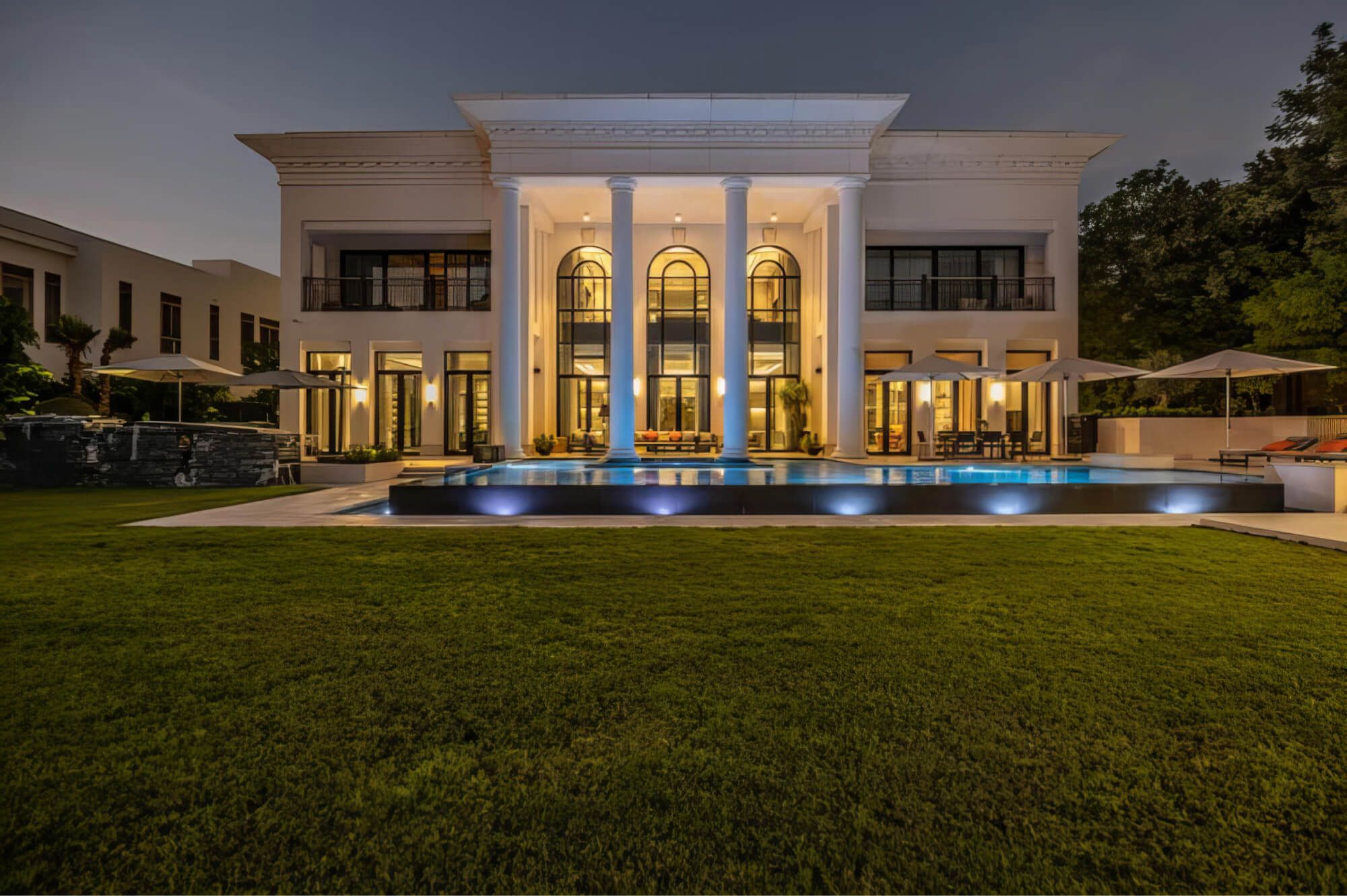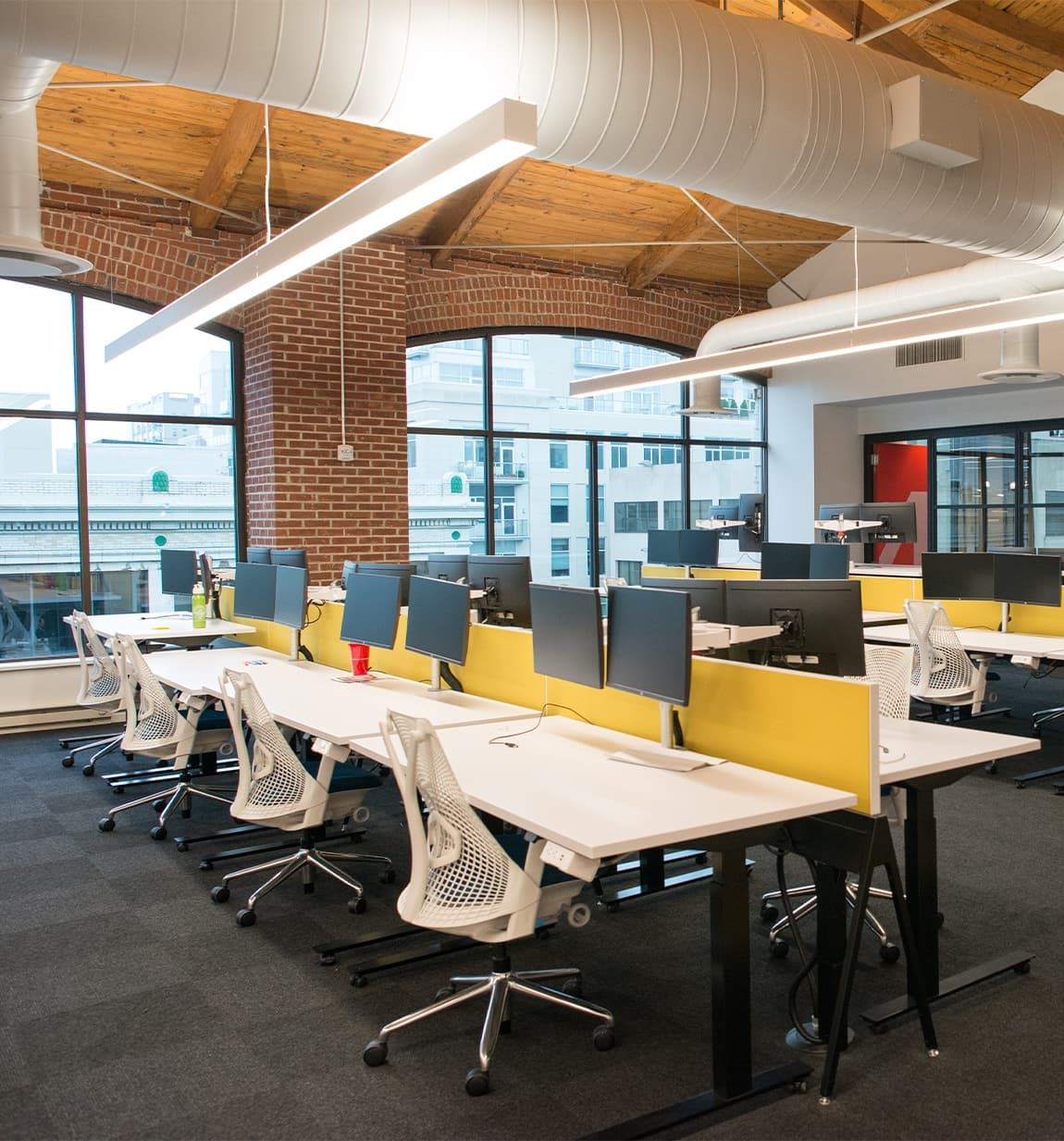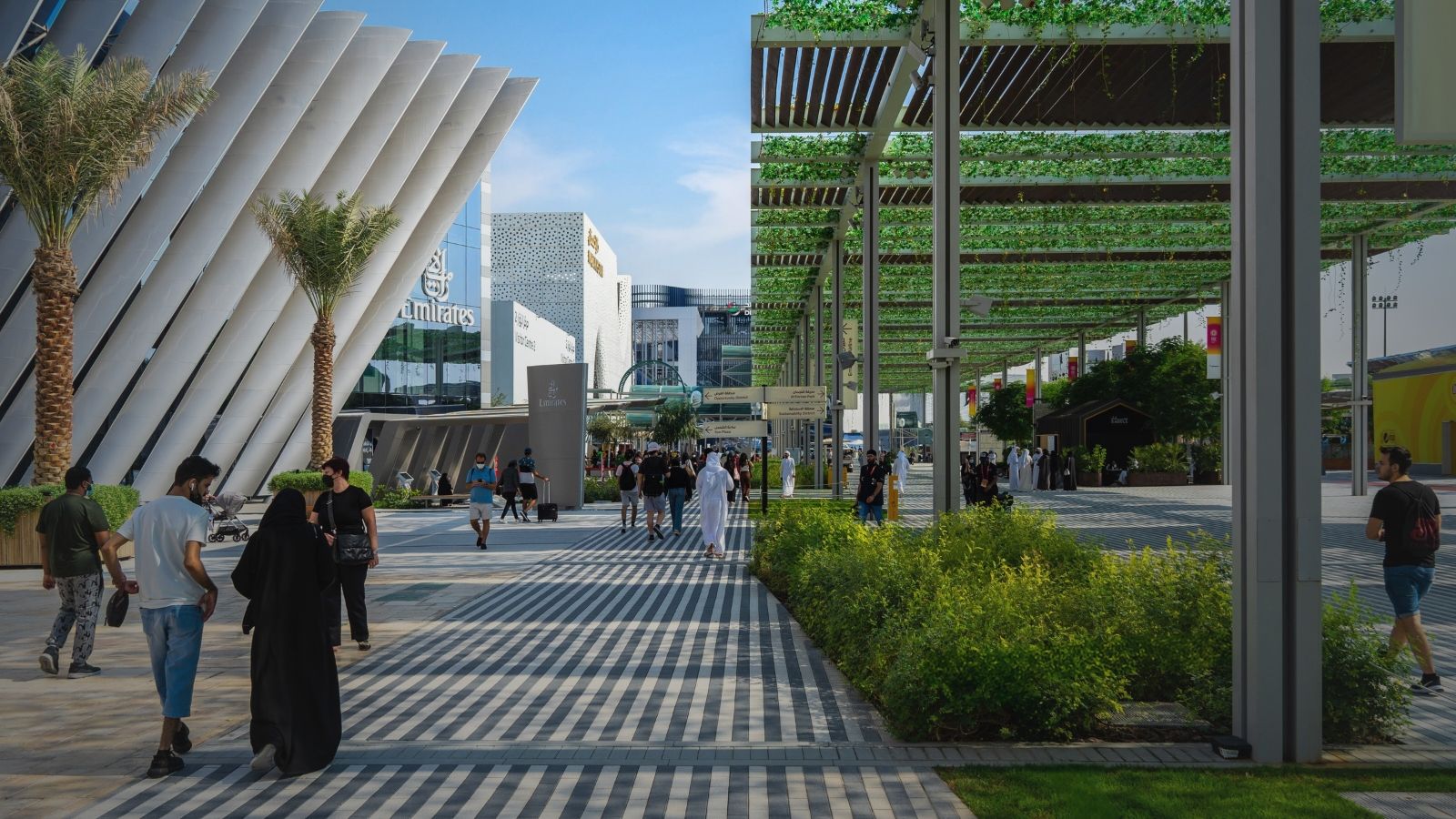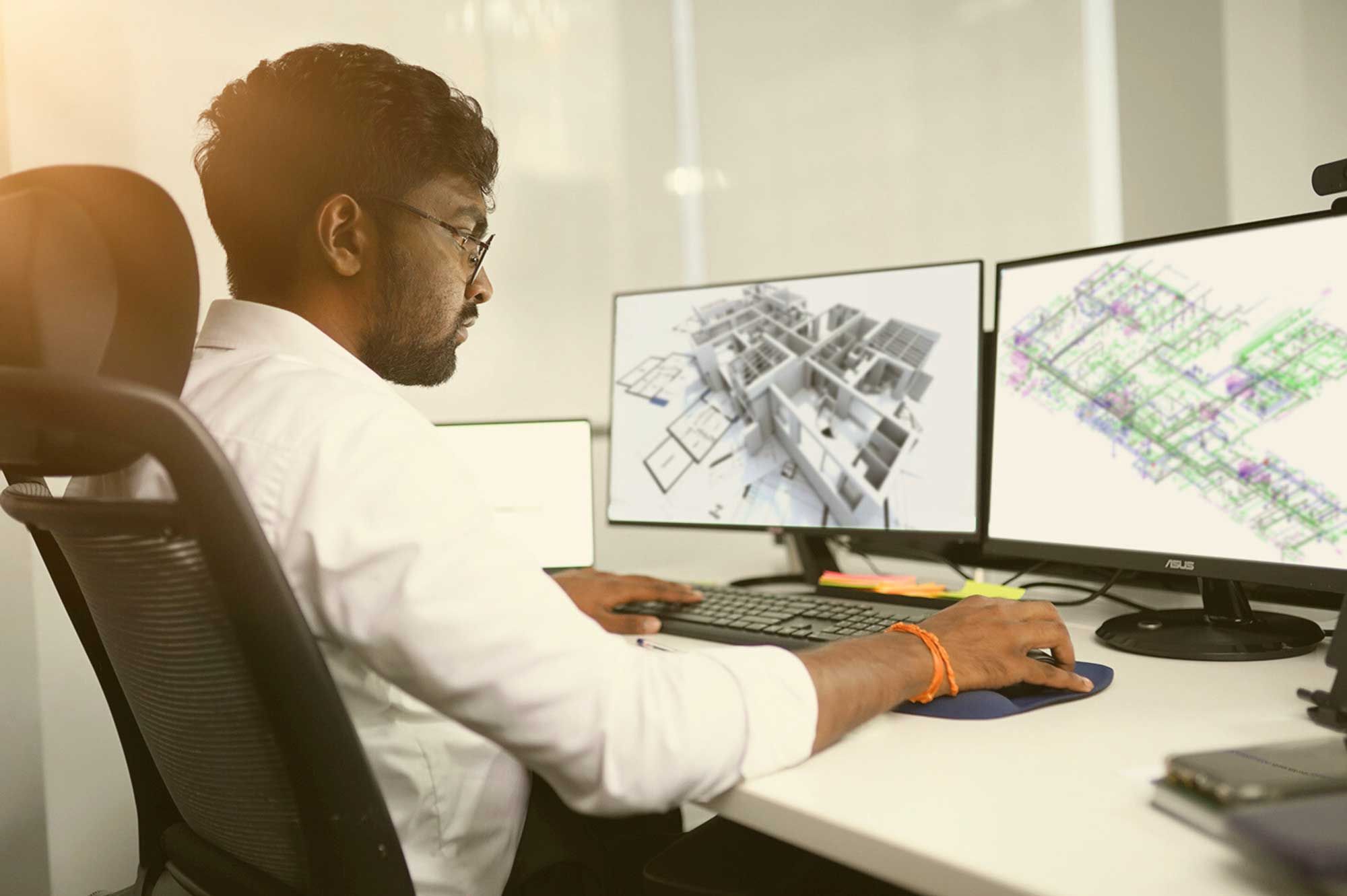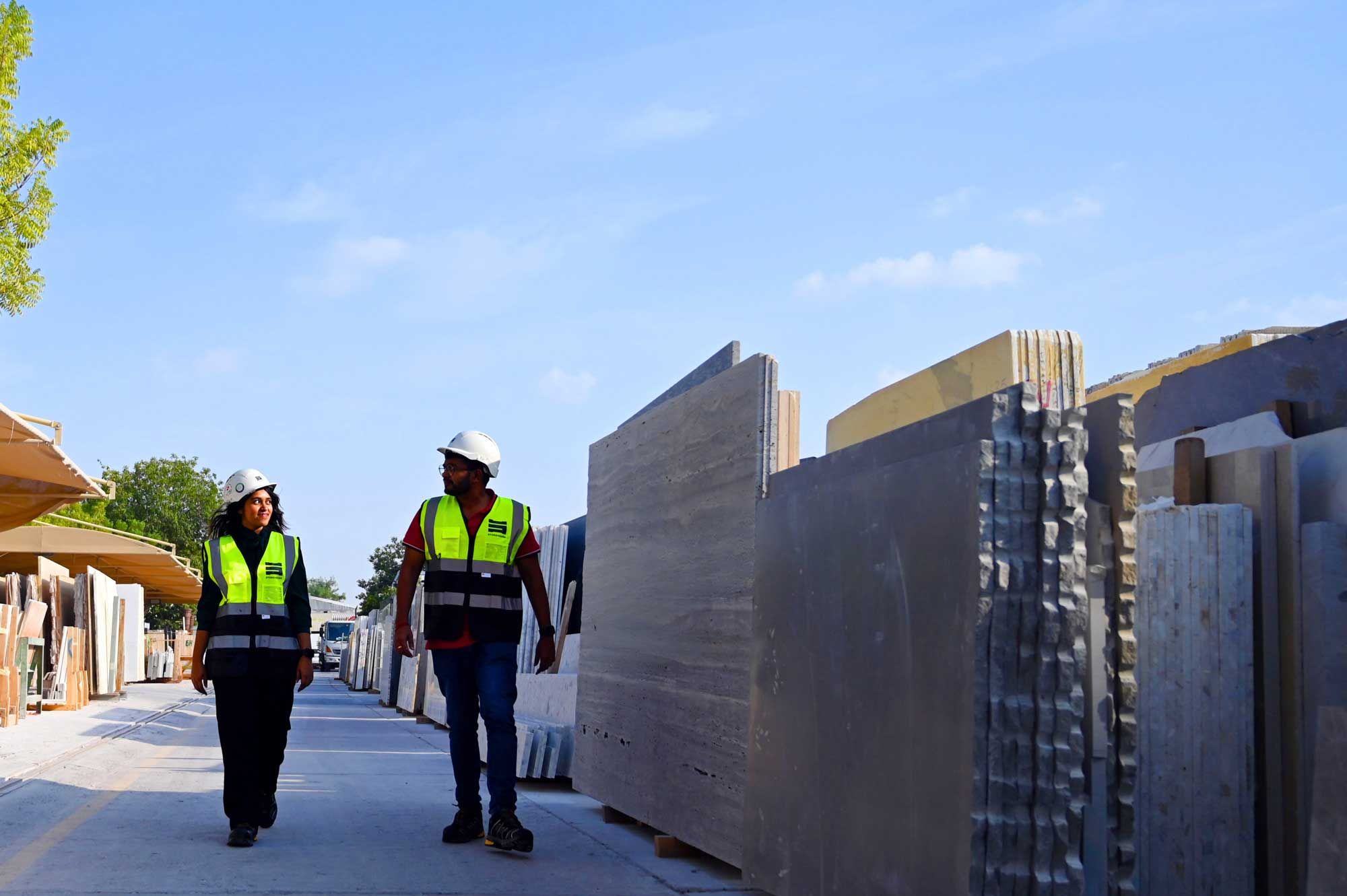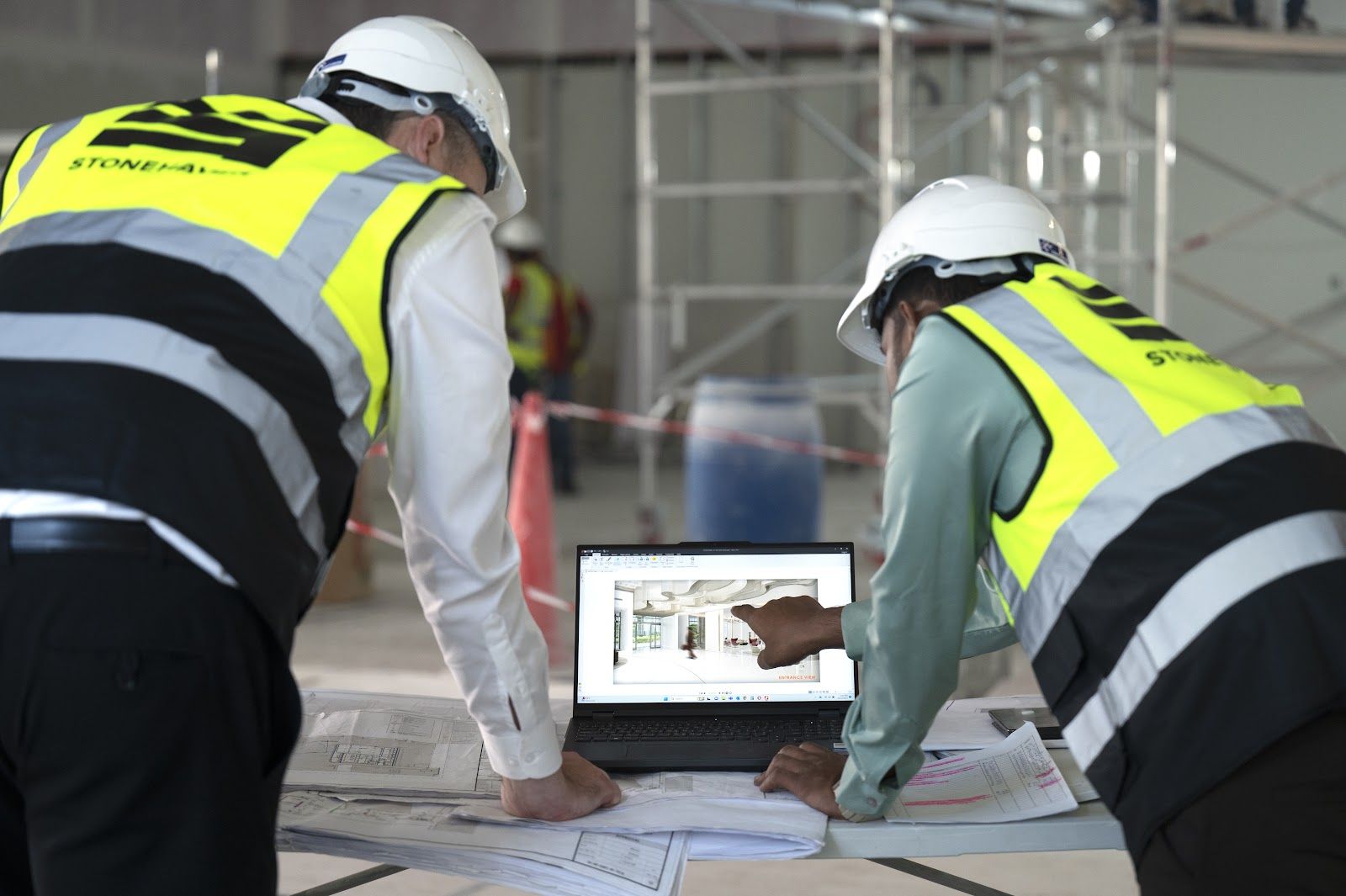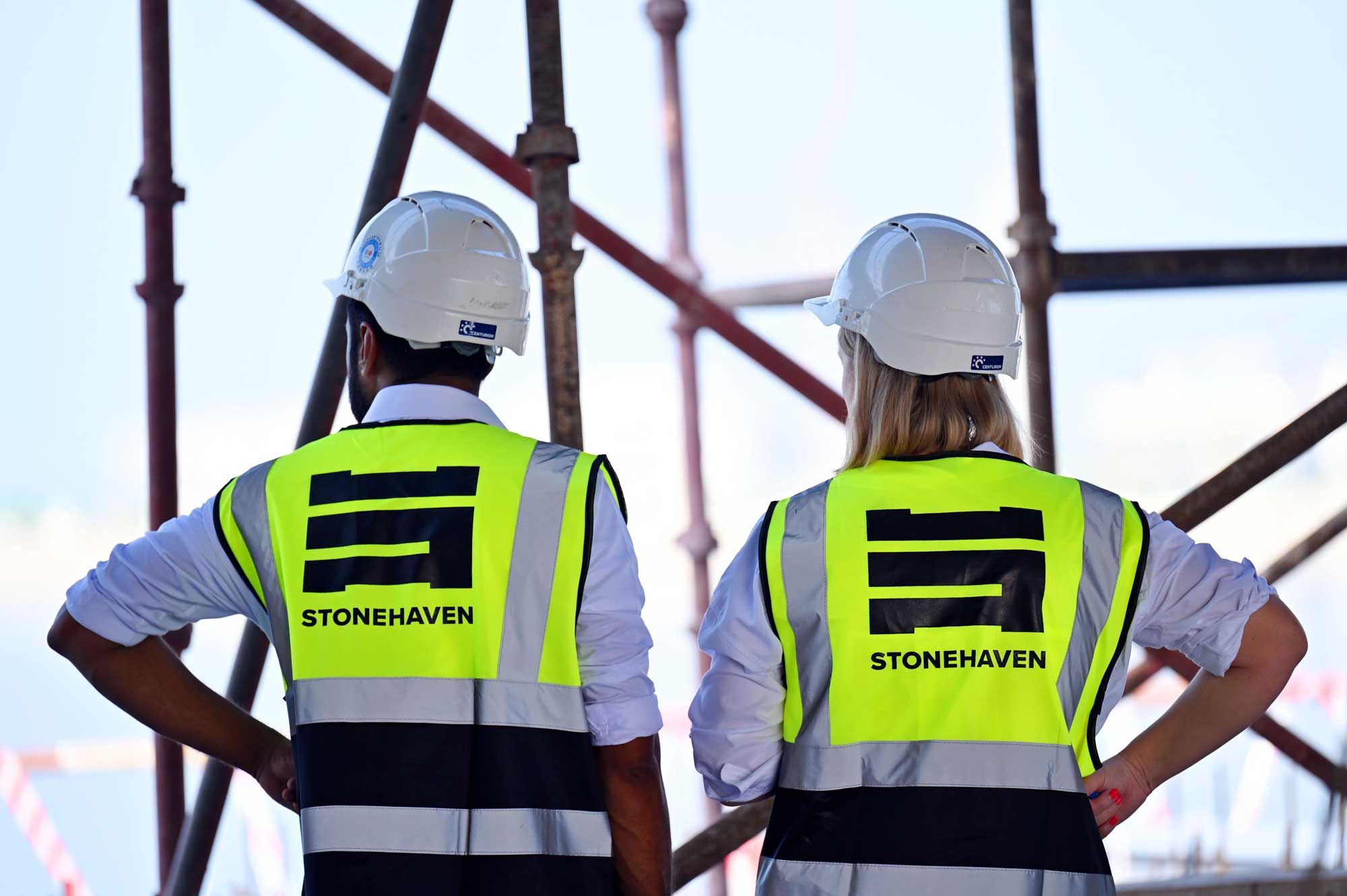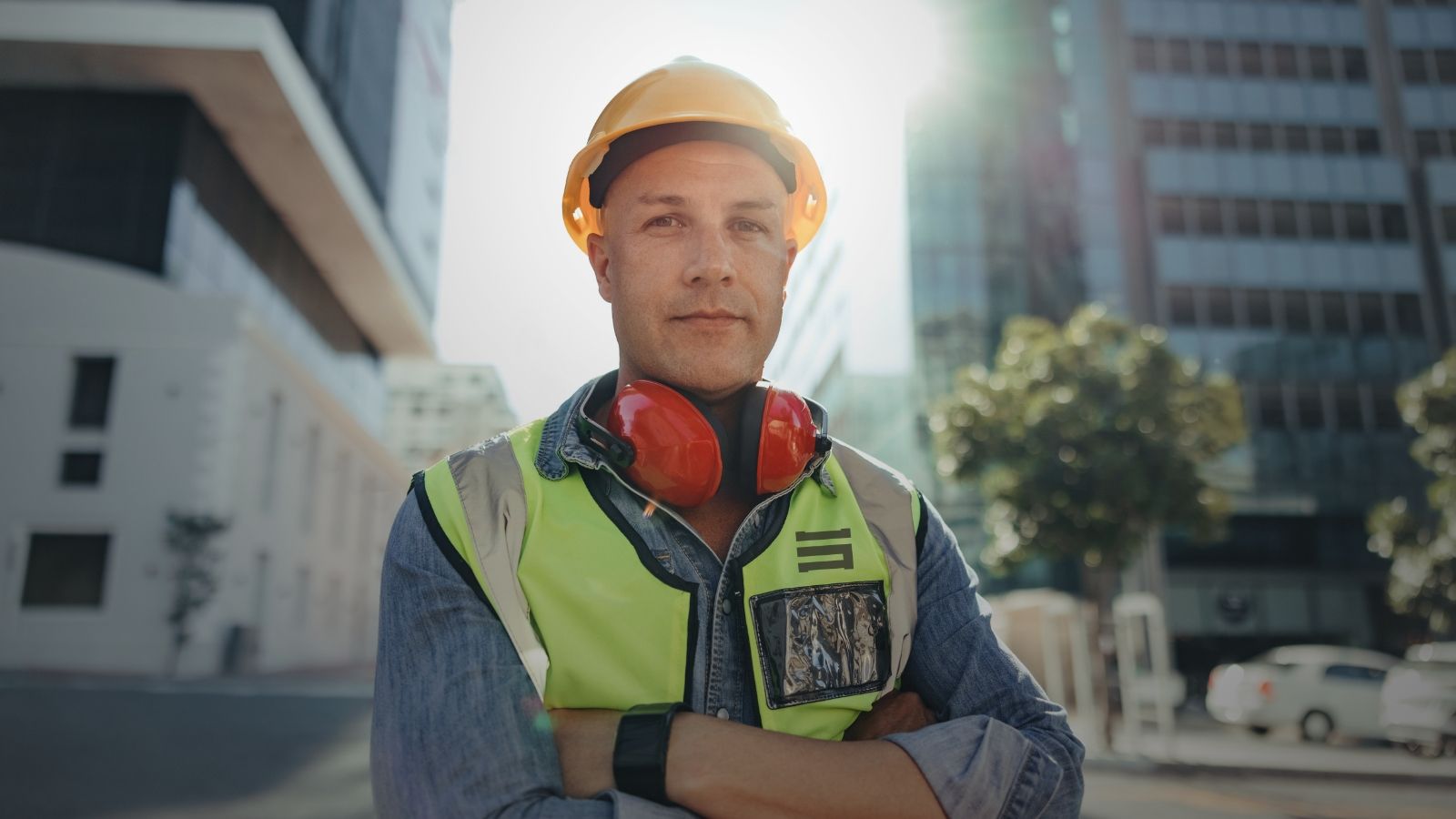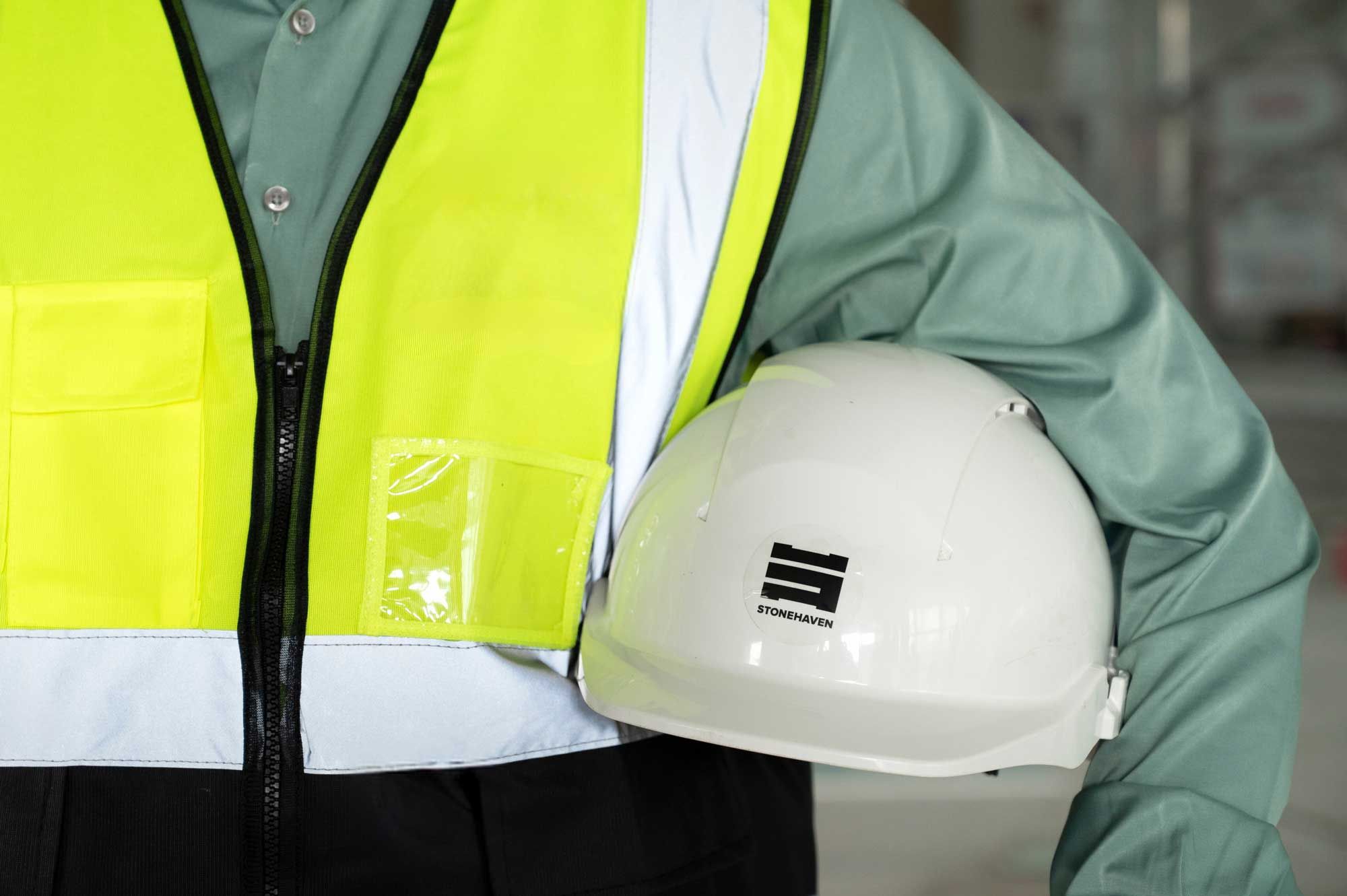Among the many innovations in the construction world, clash detection in Building Information Modelling (BIM) stands out as one of the most transformative. Why? Because it allows teams to identify and resolve design conflicts in the digital space—long before they manifest as costly delays or errors on-site.
Clash detection has become the bedrock of effective construction project management, ensuring that architectural, structural, and MEP (mechanical, electrical, plumbing) components can coexist within a single unified model. And in 2025, it’s not just about identifying overlaps anymore. With the help of AI-driven software, cloud-based platforms, and smarter workflows, clash detection is enabling construction consulting services to eliminate guesswork, improve collaboration, and dramatically reduce rework.
In the UAE, where mega-projects and fast timelines are the norm, clash detection is essential. Whether it’s a luxury high-rise in Dubai or a smart infrastructure project in Abu Dhabi, building right the first time is critical. That’s where firms like Stonehaven step in—delivering BIM coordination services that identify conflicts before they become crises.
This guide answers the most pressing questions about clash detection today: what it is, why it matters, how it works, and who’s responsible. Whether you're a developer, consultant, or contractor, this is your blueprint to understanding and mastering clash detection in construction.
What is Clash Detection in BIM?
Clash detection is the process of identifying and resolving conflicts or “clashes” within a BIM (Building Information Modelling) environment. These clashes occur when different elements of a construction design—such as ductwork, structural beams, or electrical conduits—interfere with each other spatially within a shared 3D model.
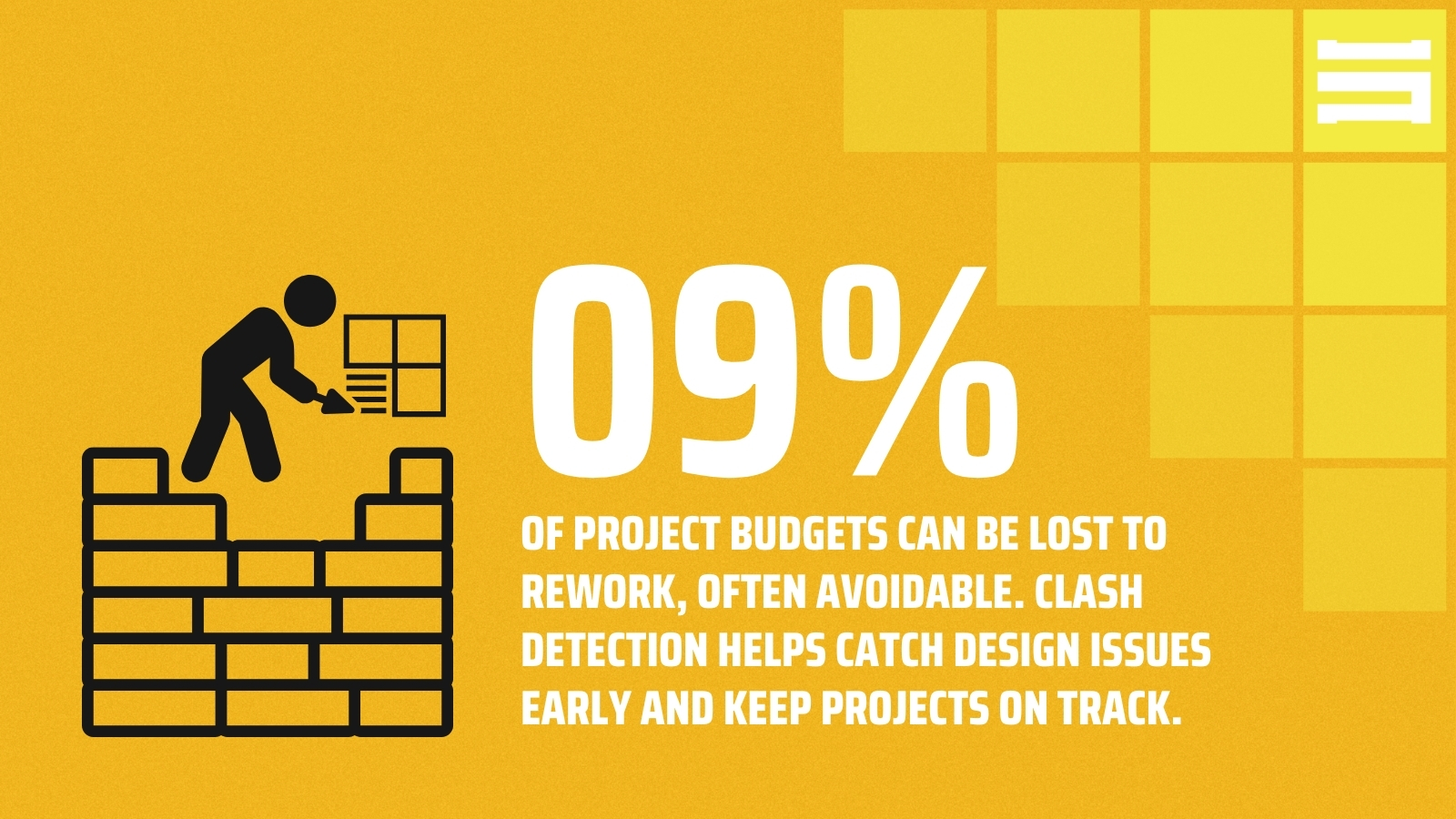
In simpler terms, it's like proofreading a building before it's constructed. Just as a spell-checker flags grammar errors in a document, clash detection flags physical conflicts in a design that would otherwise go unnoticed until materials are already installed. These could be "hard clashes" (like a pipe going through a beam) or "soft clashes" (like inadequate clearance between an HVAC unit and a ceiling).
The value of clash detection lies in its proactive power. By catching design issues early in the project management life cycle, it prevents expensive on-site rework, enhances coordination across trades, and ultimately drives more efficient project delivery.
According to Autodesk, rework can consume up to 30% of total project work, with direct costs accounting for 4–6% of overall project value. When indirect costs such as schedule delays, labour inefficiencies, and material waste are included, this figure can rise to nearly 9%. These statistics highlight why clash detection is indispensable—it acts as a front-line defence against rework by resolving design conflicts before they escalate on-site.
Modern construction technology tools like Navisworks and Revizto allow for automated clash detection, offering visual representations and detailed reports. In 2025, with cloud-based platforms and AI integration, clash detection is more intelligent, accessible, and collaborative than ever.
What are the Examples of Clash Detection?
Let’s imagine you’re designing a new office building. The structural engineer places a concrete beam across the third floor for support. Meanwhile, the MEP designer routes an HVAC duct through the same space—without realising the beam is in the way.
This is a classic hard clash: two physical elements occupying the same space. If built as-is, construction crews would hit a wall (or a beam, literally) trying to install the duct. The result? Costly change orders, delays, and potentially unsafe workarounds.
With clash detection, this problem is flagged in the digital model before construction begins. The software scans the integrated 3D model, detects the collision, and alerts the team with a visual marker and clash ID. From there, the design team collaborates to find a resolution—perhaps rerouting the duct or modifying the beam (with structural approval).
In essence, clash detection is like running a rehearsal before the show. It ensures everything fits together perfectly—structurally, spatially, and safely—so that construction can proceed without unexpected interruptions.
What are the types of Clashes in BIM?
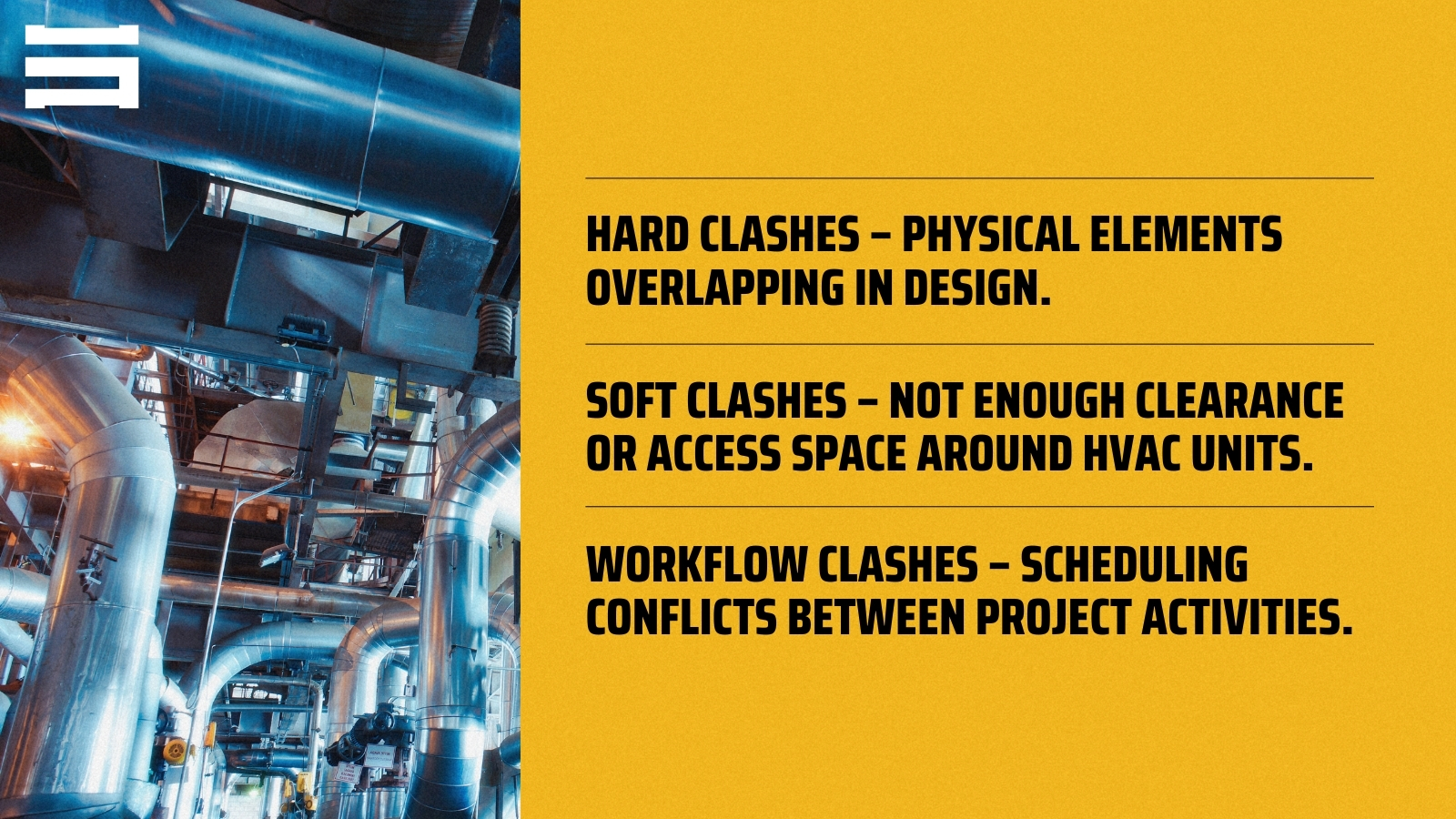
Let’s understand the types of clashes In BIM coordination to offer examples. Clashes refer to conflicts between design elements that can disrupt construction if not addressed early. Identifying and resolving these clashes during the design phase is critical to avoiding delays, cost overruns, and on-site rework. Clash detection typically focuses on three key types:
1. Hard clashes – These involve physical overlaps, such as a duct intersecting a structural beam. They represent clear conflicts that would be unbuildable in the real world.
2. Soft clashes – These occur when there’s insufficient clearance or spatial allowance, such as limited access space around an HVAC unit for maintenance, posing long-term operational issues.
3. Workflow (or 4D) clashes – These relate to scheduling and sequencing conflicts, for example, when two trades are planned to work in the same area at the same time, risking disruption or rework.
4. Coherence clash - This is also called a logical clash or data inconsistency clash. It refers to conflicts or discrepancies in the non-geometric data (metadata, properties, or parameters) of BIM elements, rather than physical collisions. These clashes occur when information in the model is inconsistent, incomplete, or contradictory across disciplines, even if the geometry appears correct.
Understanding these clash types and proactively resolving them through BIM supports smoother project delivery, better coordination, and reduced risk.
What is the Purpose of Clash Detection in BIM?
At its core, the purpose of clash detection in BIM is to prevent errors before they cost you time, money, or reputation. It serves as a proactive quality control process that protects construction projects from coordination failures that often emerge when multiple disciplines design in isolation.
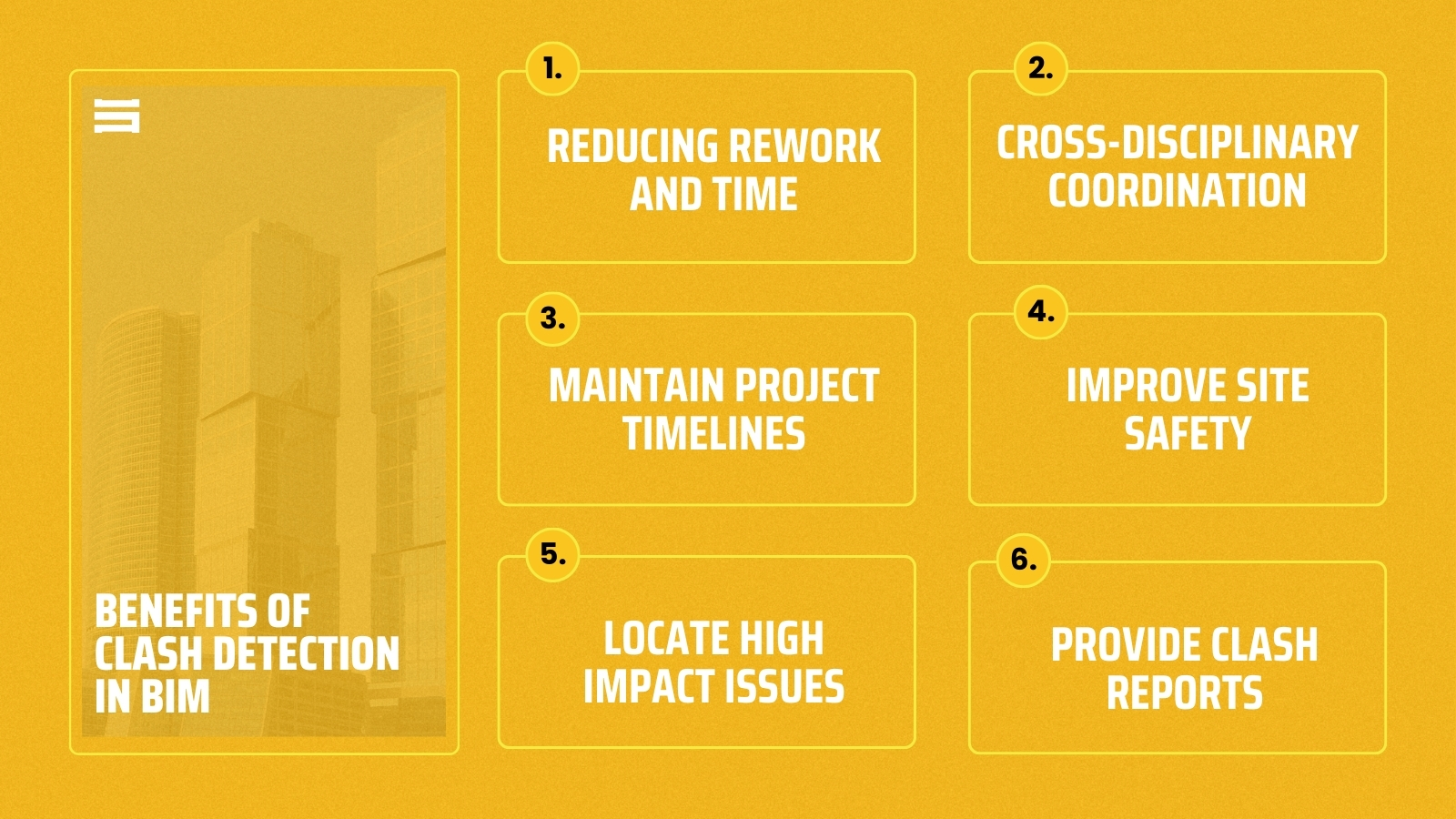
1. Reducing Rework and Time
Clash detection minimises the need for last-minute changes during construction. Studies have shown that fixing a clash during construction can cost up to 10 times more than addressing it during the design phase. Clash detection allows problems to be resolved digitally—where changes are fast, cheap, and risk-free.
2. Improving Collaborative Efforts
In a BIM environment, multiple stakeholders—architects, engineers, MEP consultants, contractors—contribute to a single model. Clash detection creates cross-disciplinary coordination by making it easier to visualise, communicate, and resolve design conflicts early.
3. Enhancing Your Project’s Efficiency
When teams start construction with a clash-free model, fewer surprises arise on site. This reduces downtime, increases productivity, and helps maintain project timelines—an essential advantage in high-speed environments like the UAE construction projects.
4. Supporting Regulatory Compliance and Safety
Some clashes (such as inadequate space around electrical panels or blocked access routes) can lead to code violations or safety hazards. Clash detection helps ensure compliance with building regulations, improving overall site safety.
5. Enabling Data-Driven Decision-Making
Modern BIM tools provide clash reports with prioritisation, allowing decision-makers to focus on the most critical conflicts. Teams can allocate time and resources more effectively, ensuring high-impact issues are resolved first.
What are the Steps Involved in Clash Detection?
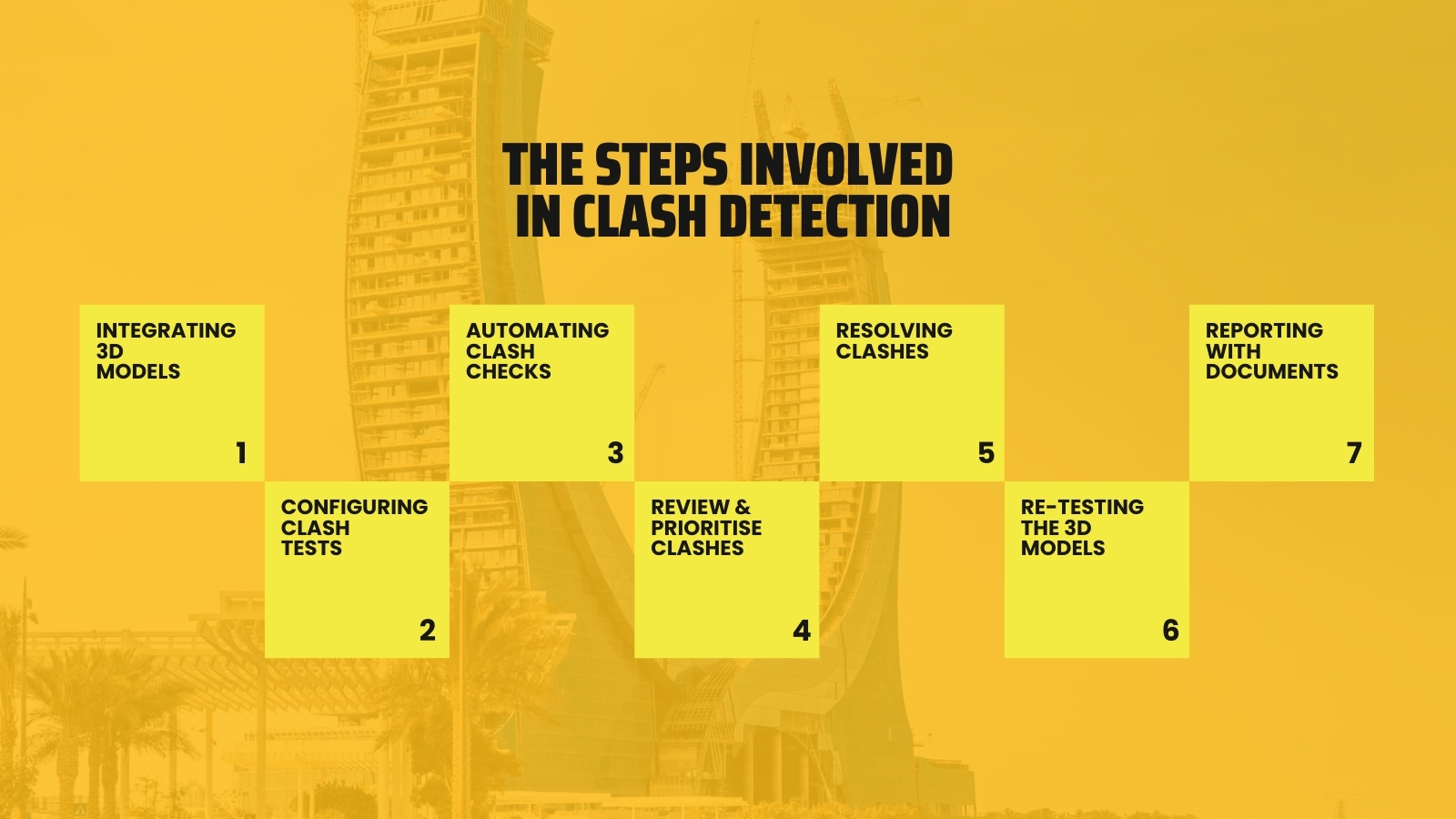
Clash detection follows a structured and iterative workflow within the BIM coordination process. Below are the typical steps that leading construction project management companies follow:
1. Model Integration
Begin by integrating 3D models from all disciplines (architectural, structural, MEP, etc.) into a federated BIM model. This unified view allows cross-disciplinary coordination.
2. Clash Test Configuration
Define clash rules within the BIM software. You can specify which systems to check (e.g., HVAC vs. beams), minimum clearance distances, and sensitivity settings.
3. Automated Clash Check
Run the clash detection tool. Software such as Navisworks or Solibri scans the model, identifying physical overlaps and spatial conflicts. Each clash is logged with a location, element ID, and screenshot.
4. Clash Review & Prioritisation
Not all clashes are equal. The team—usually led by the BIM Coordinator—reviews the results, filters out false positives, and classifies clashes by severity (hard clash vs. soft clash, critical vs. minor).
5. Clash Resolution
Design teams collaborate to resolve the clashes. For example, repositioning a duct, resizing a beam, or adjusting wall placements. This is a multidisciplinary effort involving real-time collaboration across trades.
6. Re-Testing
After each batch of fixes, the model is re-tested to verify that issues are resolved. This cycle may repeat multiple times throughout the design phase.
7. Reporting & Documentation
A clash detection report is generated to document all identified issues, resolutions, and responsible parties. These reports are crucial for tracking accountability and closing the coordination loop.
Who is Responsible for Clash Detection in BIM?
Clash detection is a team responsibility, but the process is typically led and managed by a dedicated BIM Coordinator or BIM Manager.
Primary Role: BIM Coordinator
This individual is responsible for setting up clash tests, running the software, and coordinating meetings to resolve issues. They ensure that all disciplines follow the same modelling standards and that clash reports are regularly updated and shared.
Supporting Roles in Clash Detection
-
Design Consultants (architectural, structural, MEP): Responsible for resolving clashes within their domain.
-
Project Managers: Monitor resolution timelines and align clash detection with broader construction schedules.
-
MEP Coordinators: Play a key role in resolving conflicts between mechanical systems and structural components.
-
Contractors/Subcontractors: May be involved in model review and clash resolution as the project nears construction.
Clash detection is successful when everyone is aligned and proactive. This is where construction workforce management and communication tools come into play. Real-time updates, visual dashboards, and cloud-based collaboration make it easier for all parties to stay informed and accountable.
At Stonehaven, our clash detection services are managed by a specialised BIM team embedded within our project management services. We go beyond basic clash identification—we drive resolution, engage stakeholders, and ensure a clash-free model that’s construction-ready.
Conclusion
In 2025, the construction landscape is defined by complexity, speed, and precision. With rising expectations for quality, sustainability, and coordination, there is zero room for design conflicts that lead to costly rework or dangerous site errors.
Clash detection, once seen as a back-office technical process, is now a strategic asset in all major projects in the Middle East. When done correctly, it enhances productivity, reduces risk, and fosters stronger collaboration between project stakeholders. It turns construction chaos into construction clarity.
Whether you’re building a skyscraper in Dubai or managing infrastructure in Abu Dhabi, clash detection isn’t optional—it’s essential. And at Stonehaven, we’ve made it our mission to help you build smarter, faster, and better through industry-leading BIM coordination and clash detection services.
If you’re planning a BIM-enabled project, make sure clash detection is part of your foundation.
About us
At Stonehaven, we specialise in delivering high-performance construction consulting and project management services that push the boundaries of efficiency and innovation. From concept to completion, we ensure every element of your project aligns seamlessly starting with clash detection.
As a trusted provider of BIM coordination services in the UAE, we offer:
-
Advanced clash detection using industry-leading software.
-
Full integration with your existing design and modelling teams.
-
Iterative clash management across disciplines: architectural, structural, MEP.
-
Generation of detailed clash detection reports for complete transparency.
-
Real-time resolution tracking through cloud-based tools.
-
Ongoing support throughout the project management life cycle.
We understand the unique challenges of construction in the UAE: tight deadlines, complex regulations, and ambitious architectural visions. That’s why we embed quality assurance and risk management into every project phase—from digital modelling to final handover.
Our BIM coordination specialists collaborate with your architects, engineers, and contractors to deliver conflict-free, construction-ready models. The result? Smoother workflows, shorter timelines, and reduced project costs.
Explore our clash detection and BIM services today.

